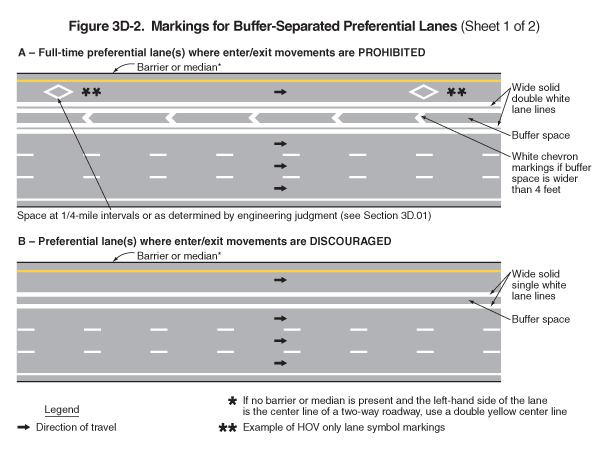2009 Edition Part 3 Figure 3D-2. Markings for Buffer-Separated Preferential Lanes (Sheet 1 of 2)

Figure 3D-2. Markings for Buffer-Separated Preferential Lanes (Sheet 1 of 2)
This figure illustrates two examples of markings for barrier-separated preferential lanes.
Two horizontal roadways are shown, A and B. A legend shows a black arrow indicating the direction of travel in the lanes.
- Figure A is labeled "Full-time preferential lane(s) where enter/exit movements are PROHIBITED." The figure shows a four-lane roadway. A solid yellow line separates the left travel lane from a shoulder, a solid white line separates the right travel lane from a shoulder, and a broken white line separates the three rightmost lanes from each other. The left shoulder is bordered on the outside by a line labeled "barrier or median" with a note that states: "If no barrier or median is present and the left-hand side of the lane is the center line of a two-way roadway, use a double yellow center line." The right shoulder is bordered on the outside by a line labeled "barrier or physical separation from general purpose lanes." Arrows indicate that the direction of travel is from the left of the figure to the right. The leftmost preferential lane is shown separated from the other three by wide solid double white lane lines to the right of the left lane, a buffer space, and more wide solid double white lane lines that are to the left of the left through lane. The buffer space is shown with white chevron markings pointing to the left (against the direction of travel) that are noted as "white chevron markings if buffer space is wider than 4 feet." White elongated diamonds are shown marked on the pavement of the left preferential lane with the note: "Space at 1/4-mile intervals or as determined by engineering judgment (see Section 3D.01)." These markings are noted as an example of HOV only lane symbol markings.
- Figure B is labeled "Preferential lane(s) where enter/exit movements are DISCOURAGED." The figure shows a four-lane roadway. A solid yellow line separates the left travel lane from a shoulder, a solid white line separates the right travel lane from a shoulder, and a broken white line separates the three rightmost lanes from each other. The left shoulder is bordered on the outside by a line labeled "barrier or median" with a note that states: "If no barrier or median is present and the left-hand side of the lane is the center line of a two-way roadway, use a double yellow center line." Arrows indicate that the direction of travel is from the left of the figure to the right. The leftmost preferential lane is shown separated from the other three by a wide solid single white lane line to the right of the left lane, a buffer space, and another wide solid single white lane line that is to the left of the left through lane.
Continue to: Sheet 2
